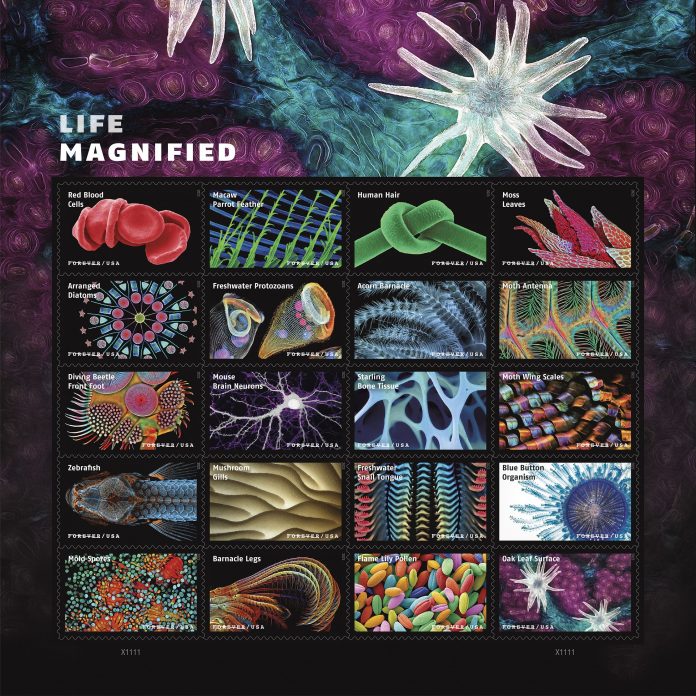CLEVELAND, August 10, 2023 — A dedication ceremony for Life Magnified stamps was held in partnership with the American Philatelic Society at the Great American Stamp Show in Cleveland. The 20 stamps feature otherworldly images of some of the smallest components of life as we know it.
“Usually, we shrink images to fit on a postage stamp. In this case, we have enlarged the images to postage-stamp size — that doesn’t happen often,” said Luke Grossmann, senior vice president of finance and strategy for the Postal Service. “There’s a famous adage, ‘The more you know, the more you realize you don’t know.’ As these stamps show, there are worlds to be explored, even at the microscopic level.”
Using microscopes and specialized photographic techniques, the stamp images capture details of red blood cells, the feather of a macaw, a knotted strand of human hair, moss leaves, diatom shells, freshwater protozoans, an acorn barnacle, a moth’s antenna, the front foot of a diving beetle, neurons from a mouse’s brain, bone tissue from a starling, scales on the wing of a Madagascan sunset moth, a juvenile zebrafish, mushroom gills, the tongue of a freshwater snail, a blue button (similar to a jellyfish), mold spores, the legs of a barnacle, flame lily pollen, and the surface of a southern live oak leaf.
“I am honored to be a part of the Life Magnified stamp issue, which is such a powerful way to communicate the discovery inherent in scientific imaging with the public. Much of the biological world cannot be seen by eye, and microscopy reveals the intrinsic beauty of nature as the camera zooms in,” said Dr. Tagide de Carvalho, director of the Keith R. Porter Imaging Facility at the University of Maryland, Baltimore County.
Dr. Igor Siwanowicz, a research scientist at the Howard Hughes Medical Institute, said, “For anyone that is not an expert in the field, microscopy images, with all of their alien, sometimes abstract shapes, may cause confusion. Hopefully, this is the good kind of confusion …Good confusion causes a certain degree of discomfort, a mental itch that comes with the recognition of a gap in one’s knowledge. Hopefully, these stamps will promote that itch within the public and inspire individuals to acquire knowledge to explain the nature of the imaged subject.”
Also participating in the dedication ceremony were Scott English, executive director of the American Philatelic Society, and Ken Martin, the society’s director of expertizing.
For hundreds of years, scientists have held a deep fascination with making the invisible elements of our world visible. Development of more refined microscope techniques over several centuries brought smaller and smaller components of life into focus. By the 20th century, microscopes had become ubiquitous in laboratories around the globe. Electron microscopes are now essential tools in several scientific fields.
The images that result from microscope-based research show, in exquisite detail, the phenomena of life. Stunning on their own as works of art, these images also hold scientific significance. Daniel Castranova’s photograph of a juvenile zebrafish, for instance, reveals the presence of lymphatic vessels within the fish’s skull, previously never observed in the skulls of non-mammals. This groundbreaking discovery may help scientists form a better understanding of human diseases.
Microscopists use a variety of techniques to capture the beauty of their subjects.
Confocal microscopy scans a specimen to create several optical sections of the subject. The images are then stacked to provide an extended depth of field for a three-dimensional reconstruction.
The Köhler illumination technique eliminates uneven lighting in the viewable area of a microscope lens. Fluorescence imaging uses special dyes that are absorbed by a sample to fluoresce color when excited by high-intensity lighting, making the sample glow.
By incorporating aesthetic appeal into the ways they present their research, scientists have created images equally suited for a gallery wall as for a scientific journal. Their work reveals the grandeur of life at an infinitesimal scale.
Derry Noyes, an art director for USPS, designed the stamps and the pane using existing photographs.
The Life Magnified stamps, issued in panes of 20, are Forever stamps. Forever stamps will always be equal in value to the current First-Class Mail 1-ounce price. News of the stamps is being shared with the hashtag #LifeMagnifiedStamps.
Postal Products
Customers may purchase stamps and other philatelic products through the Postal Store at usps.com/shopstamps, by calling 844-737-7826, by mail through USA Philatelic, or at Post Office locations nationwide. For officially licensed stamp products, shop the USPS Officially Licensed Collection on Amazon.
Please Note: The United States Postal Service is an independent federal establishment, mandated to be self-financing and to serve every American community through the affordable, reliable, and secure delivery of mail and packages to nearly 165 million addresses six and often seven days a week. Overseen by a bipartisan Board of Governors, the Postal Service is implementing a 10-year transformation plan–Delivering for America–to modernize the postal network, restore long-term financial sustainability, dramatically improve service across all mail and shipping categories, and maintain the organization as one of America’s most valued and trusted brands.
The Postal Service generally receives no tax dollars for operating expenses and relies on the sale of postage, products, and services to fund its operations.


